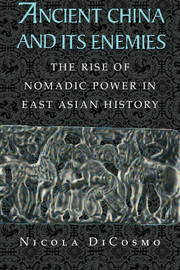Book contents
- Frontmatter
- Contents
- Acknowledgments
- Introduction
- Part I
- Part II
- Part III
- 5 Those Who Draw the Bow: The Rise of the Hsiung-nu Nomadic Empire and the Political Unification of the Nomads
- 6 From Peace to War: China's Shift from Appeasement to Military Engagement
- Part IV
- Conclusion
- Glossary
- Select Bibliography
- Index
5 - Those Who Draw the Bow: The Rise of the Hsiung-nu Nomadic Empire and the Political Unification of the Nomads
Published online by Cambridge University Press: 25 August 2009
- Frontmatter
- Contents
- Acknowledgments
- Introduction
- Part I
- Part II
- Part III
- 5 Those Who Draw the Bow: The Rise of the Hsiung-nu Nomadic Empire and the Political Unification of the Nomads
- 6 From Peace to War: China's Shift from Appeasement to Military Engagement
- Part IV
- Conclusion
- Glossary
- Select Bibliography
- Index
Summary
Introduction
Before the Ch'in unification in 221 b.c., the northern states were able to “contain” the nomads, to push them away from the borders, and to inflict upon them resounding defeats, all without much trouble. In contrast, having emerged from the smoldering ashes of the Ch'in, the Han dynasty (202 b.c.–A.D. 9) was forced for decades to accept humiliating peace treaties and, being incapable of defending the borders effectively, was subject to the nomads' initiative both politically and militarily. Unless the point is made that the nomads at the time of the late Warring States period were qualitatively different from the Hsiung-nu of the Han period, we would have to conclude, paradoxically, that the states of Chao and Yen were more powerful and effective in their struggle against the nomads than the Han dynasty under Kao-tsu (206–195 b.c.), Wen-ti (179–157 b.c.), or Ching-ti (156–141 b.c.).
Seeking a solution to the “mystery” of the ethnic origin of the Hsiung-nu, much has been said on the linguistic affiliation of the Hsiung-nu and other possible indicators of their ethnicity. This debate, of which I present a summary in the first part of this chapter, has been so far inconclusive, and opinions as to the language and ethnicity of the Hsiung-nu remain divided. A more promising line of investigation, based on anthropological and historical questions, has concentrated on the economic and other social mechanisms that may have played a role in the formation of nomadic empires.
- Type
- Chapter
- Information
- Ancient China and its EnemiesThe Rise of Nomadic Power in East Asian History, pp. 161 - 205Publisher: Cambridge University PressPrint publication year: 2002



